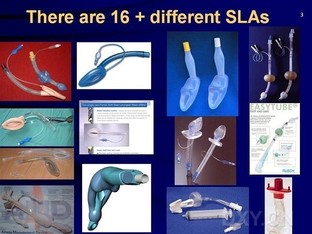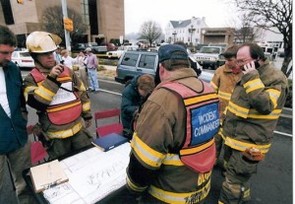|
You may not have heard of Jim DuCanto specifically, but you have probably heard about his SALAD (Suction Assisted Laryngoscopy Airway Decontamination) technique. Click on the links that we have here if you have not heard of him or his technique including this one from Life in the Fast Lane. Don't worry, we will wait right here...
Are you back now? Does it make sense? We will talk about it more soon. However, we had a very unique conversation about something you most likely have not heard of yet. On August 28, 2016 he completed an experiment regarding supraglottic airways. The next day we interviewed him with this podcast being all about the experiment. Click below for some of the key points from our talk. 
As a reminder, there are many different types of supraglottic airways. Not all are created the same and there are many differences. We will go into further detail in our next podcast, but keep in mind as the picture shows, there are many different options out there each with both positive and negative aspects. As pointed out in this podcast though, they all seem to have some risk for aspiration. However, some have more compared to others based on this study but we must remember that the study itself was limited to one manikin design.
Airway Nautics has a detailed description of how to make your own vomiting manikin but there was some information given in this podcast specifically. The first little pearl given is regarding pumps. When looking for a sump pump, pick the lowest horse power possible or you will most likely overwhelm the system. He specifically mentions 1/10th horse power. You will want a drill with a drill pump to vary the speed and amount for better flow rate control. Find a pump that is driven by an electric drill (preferably cordless). The reason you want cordless is because you are dealing with electricity around fluids! Remember, you are working around "wet stuff" with "electric stuff" which can mean shock. Please be VERY careful on this point. If you are not sure what you are doing, talk to an expert. There are two videos on Vimeo with one being from 2015 and the other from 2016 regarding how to set up your own vomiting manikin. As with anything in education, but particularly with difficult techniques such as SALAD, start simple. Use a static approach first. This means that the foreign material in the airway is not moving nor is there more coming. Work slowly to develop a dynamic situation with slowly increasing the amount and complexity. This does two things. It builds confidence and allows for a more complete experience. Allow your learner to give a full understanding. Do NOT teach through failure! Remember, slow is smooth and smooth is fast. Listening to Jim DuCanto, he is obviously very intelligent and experienced. In a difficult situation, he does not always take back the situation if someone else is doing the management. This is beneficial in multiple ways but two very important parts are about teaching the future and building confidence. In a difficult situation and someone who is competent, just because you may have more knowledge or experience may not mean you can do better. He discusses this more with a specific scenario. The other important factor is that if you are the one with more authority, you will one day need to give it to someone else if you move, retired, et cetera. If the situation is appropriate, let someone else take lead and be involved as needed. The person you are teaching or working with should be able to tell you when they have hit their limits. 
Let us bring up the example of firefighting. You may not be firefighters, but the situation is probably similar to what has happened in the past. When a junior officer is first on an emergency scene, they usually take command. A chief officer may later come but the chief has the option of either offering to take command or not. As this picture illustrates, the white helmet is not always in charge. In many cases, with resources and situation being appropriate, the chief officer may stand back and simply observe or direct as needed. This allows for safe knowledge translation that will help reinforce what you want from someone more junior who may one day take the reins. Be like that chief officer and stand back when possible.
Do you think that Jim DuCanto only talks about the SALAD approach to airway management? Of course not! In fact, he has a very interesting paper we briefly talked about after our discussion. You can find the article here. It is quite the unique read. If you have any questions for our guest, he is available on Twitter. You can Direct Message him there if you would like. We hope you enjoyed our podcast. Do you have any questions? You can post it in the comments section, go to Facebook, or go to Twitter. We are available across the board. Stay tuned in the upcoming weeks for more interviews including more from Jim DuCanto and other airway experts. Until next time, continue to provide total care everywhere.
0 Comments
Leave a Reply. |
Libsyn and iTunesWe are now on Libsyn and iTunes for your listening pleasure! Archives
August 2022
Categories |
||||||


 RSS Feed
RSS Feed